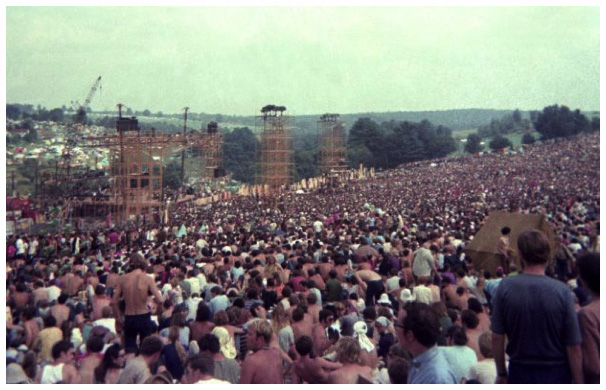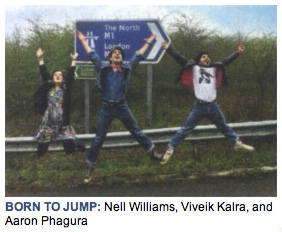![]()
| Back to the Garden |
|
![]()
Fifty years after the original Woodstock, the festival's
legacy is as influential -- and messy -- as ever.
By Christian Holub in Entertainment Weekly

![]() n a town 106 miles north of New York City, a series of rolling hills marks the site of the most famous festival in American history. Held 50 years ago this August, "An Aquarian Exposition: 3 Days of Peace & Music," better known as Woodstock, was variously seen as the culmination of the 1960s and a watershed moment for rock & roll.
n a town 106 miles north of New York City, a series of rolling hills marks the site of the most famous festival in American history. Held 50 years ago this August, "An Aquarian Exposition: 3 Days of Peace & Music," better known as Woodstock, was variously seen as the culmination of the 1960s and a watershed moment for rock & roll.
"There's a lot of mythology around Woodstock," says Barak Goodman, director of the new PBS film Woodstock: Three Days That Defined a Generation. "Half a million people went, but 10 times that number think they went."
That mythology is preserved and clarified at Bethel Woods Center for the Arts, a nonprofit center situated on the historic location, a few dozen miles from the town of Woodstock. A large plaque adorned with artist names and the festival's iconic symbol of a dove sitting on a guitar marks the physical spot of the actual performances.

|
"I had come from the West Coast," Fogerty says. "I think we ended up landing in Albany and were driven from there. But then our tour manager, Bruce Young, called. He said, 'You're not going to believe this, but everybody has left their automobile on the freeway; it's a jam. So if you're going to get there, you have to walk in.'" By the time the band had arrived, Fogerty was worried about the number of people on site. "I really had a sense of foreboding. Nothing bad happened -- but I was sure aware that it could have."
The great miracle of the original Woodstock was how many potential setbacks were avoided through innovative thinking. While a festival like Altamont was plagued by violence, original Woodstock organizer Michael Lang and his associates hired members of a hippie commune called the Hog Farm, who guided attendees through bad trips ("Beware the brown acid!") and set up a free kitchen. That magic has been hard to replicate at more recent Woodstock outings. The grounds of the '94 edition were so bad, the fest was nicknamed "Mudstock," and Woodstock '99 devolved into a riot, thanks to the sweltering heat, scant water supplies, and an aggressive crowd (multiple sexual assaults were reported). A 2019 incarnation also organized by Lang, meanwhile, appears too mired in mishaps to materialize at all.


 Despite the potential lack of a large-scale event, Woodstock's anniversary will still be commemorated in upstate New York. The Bethel Woods Center is hosting multiple celebrations in August, with performances from Ringo Starr, Santana, and Fogerty -- whose original set with CCR in 1969 still brings back memories. "There's a lot of revisionist history between what actually happened and what I remember happening. But I remember Creedence, I remember Sly & the Family Stone," recalls Jocko Marcellino of Sha Na Na, who played prior to Jimi Hendrix at Woodstock.
Despite the potential lack of a large-scale event, Woodstock's anniversary will still be commemorated in upstate New York. The Bethel Woods Center is hosting multiple celebrations in August, with performances from Ringo Starr, Santana, and Fogerty -- whose original set with CCR in 1969 still brings back memories. "There's a lot of revisionist history between what actually happened and what I remember happening. But I remember Creedence, I remember Sly & the Family Stone," recalls Jocko Marcellino of Sha Na Na, who played prior to Jimi Hendrix at Woodstock.
Still, separating Woodstock fact from fiction is harder than it sounds. "People tend to say, 'Oh, there was tie-dye all over the place,'" says Charlie Maloney, 68, a '69 attendee who now volunteers as a docent at the center. "You look through all these pictures, you will only find two people in tie-dye: John Sebastian and Joe Cocker.... You always hear people were starving. We may have been hungry at times, but the town provided sandwiches."
One thing there's no confusion over is Woodstock's antiwar sentiment. Although festivals have come to dominate the American music scene in the decades since, few put as much emphasis on "peace" as on "music." Perhaps it's because today's crowds aren't staring down the barrel of a military draft the way Woodstock attendees were during the Vietnam era.
Though there is no particular political bent to this year's anniversary celebrations, the memory of Woodstock -- where for three days, hundreds of thousands of young people lived together harmoniously and joyously in their own makeshift city -- serves as an example of what is possible.
"Group action can actually accomplish things and change the trajectory of history if enough people buy in," Goodman says. "We can do something collectively by banding together, by adopting communal values, and deciding we want to change things. I think that's really the lesson and legacy of Woodstock." ![]()
 Fixin' to Sing Along at Woodstock (Again) Much of the cultural perception of Woodstock was shaped by the eponymous 1970 documentary directed by Michael Wadleigh. The film contains several iconic moments, including singer Country Joe McDonald launching into his rousing antiwar chant, "I-Feel-Like-I'm-Fixin'-to-Die Rag" (the chorus: "One, two, three, what are we fighting for?"). "When you're playing in open air, the sound goes up, so you can't really hear people singing or clapping," the singer, now 77, says. "When I saw the footage, I could actually see that they were really responding. I don't think I really knew that. That's why in the middle of the song, I yell at them to sing louder, because from the stage I really couldn't hear." Fixin' to Sing Along at Woodstock (Again) Much of the cultural perception of Woodstock was shaped by the eponymous 1970 documentary directed by Michael Wadleigh. The film contains several iconic moments, including singer Country Joe McDonald launching into his rousing antiwar chant, "I-Feel-Like-I'm-Fixin'-to-Die Rag" (the chorus: "One, two, three, what are we fighting for?"). "When you're playing in open air, the sound goes up, so you can't really hear people singing or clapping," the singer, now 77, says. "When I saw the footage, I could actually see that they were really responding. I don't think I really knew that. That's why in the middle of the song, I yell at them to sing louder, because from the stage I really couldn't hear."The song also came prefaced with an F-word chant at a time when such profanities were not nearly as commonplace in public as they are today. "It made me infamous and famous at the same time," says McDonald. "My most famous song really couldn't get airplay. It got me banned from municipal auditoriums for a long time after. So I paid a price. But I'm proud to say that I've carried with me the reality of the Vietnam War. I'm the elephant in the room." - Christian Holub |
| Hungry Hearts |
|
![]()
The new Springsteen-themed movie 'Blinded by
the Light' is a tribute to the power of music.
 Blinded by the Light
Blinded by the Light
STARRING Viveik Kalra, Kulvinder Ghir, Hayley Atwell
DIRECTED BY Gurinder Chadha
RATING PG-13
LENGTH 1 hr., 54 mins.
RELEASE DATE Aug. 14
By Leah Greenblatt in Entertainment Weekly
![]() ove, faith, Springsteen: That and a Sony Walkman are pretty much all it takes to surrender to Blinded by the Light, a Technicolor ode to the power of music so purely heartfelt that it disarms even the most misanthropic critic's instincts.
ove, faith, Springsteen: That and a Sony Walkman are pretty much all it takes to surrender to Blinded by the Light, a Technicolor ode to the power of music so purely heartfelt that it disarms even the most misanthropic critic's instincts.
Based on a memoir by British journalist Sarfraz Manzoor, Light tells the story of Javed (Viveik Kalra), an Anglo-Pakistani teenager living in the grim downturn of Thatcher-era '80s England. He wants to be a writer one day, a dream that his strict immigrant parents dismiss out of hand.
But he does have a teacher (Hayley Atwell) who believes in his talent, and a new friend (Aaron Phagura) who literally rocks his world by handling him his first cassette of the man he'll come to know not just as Bruce, but as his own personal Boss and savior. This is no remote American rock star exalting fast girls and pretty cars, but a true working-man's hero who understands every thwarted hope in Javed's heart.
The appealing diversity of the cast and gentle touch of director Gurinder Chadha (Bend It Like Beckham) render the shiny tropes of jukebox musicals and young romance somehow fresh again. Together they sell the story with such sweet conviction, it's hard not to want to dance in the dark -- and follow them all into the light. B+ ![]()
![]() Reader's Comments
Reader's Comments
No comments so far, be the first to comment.
